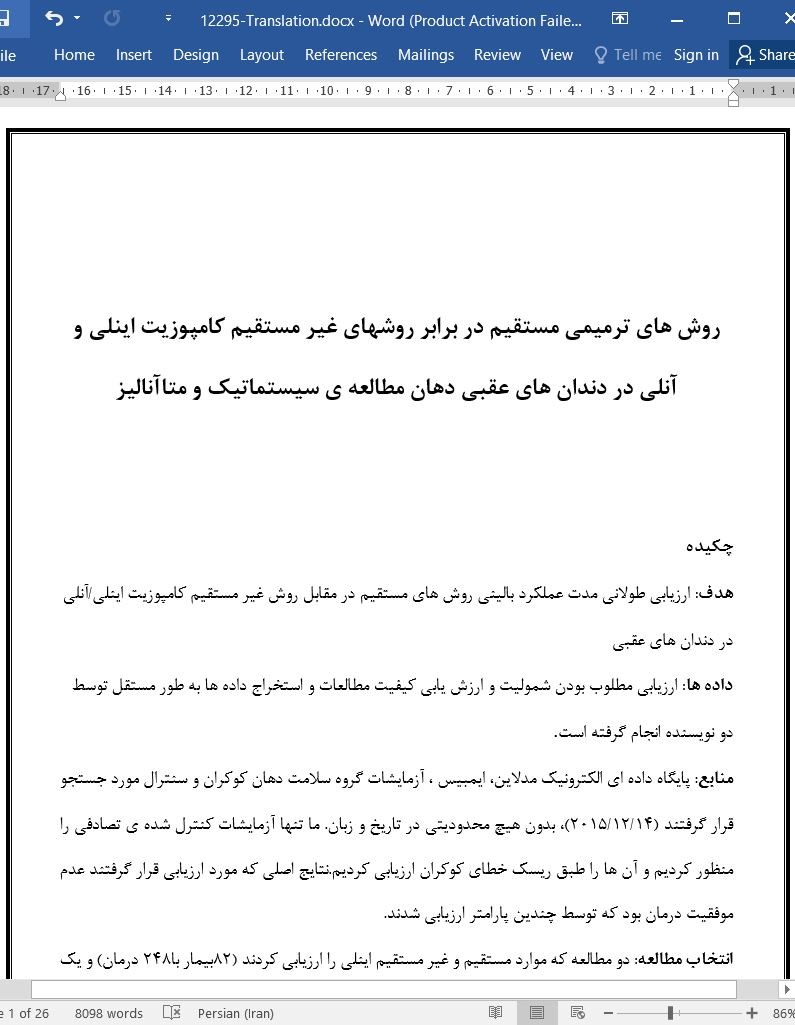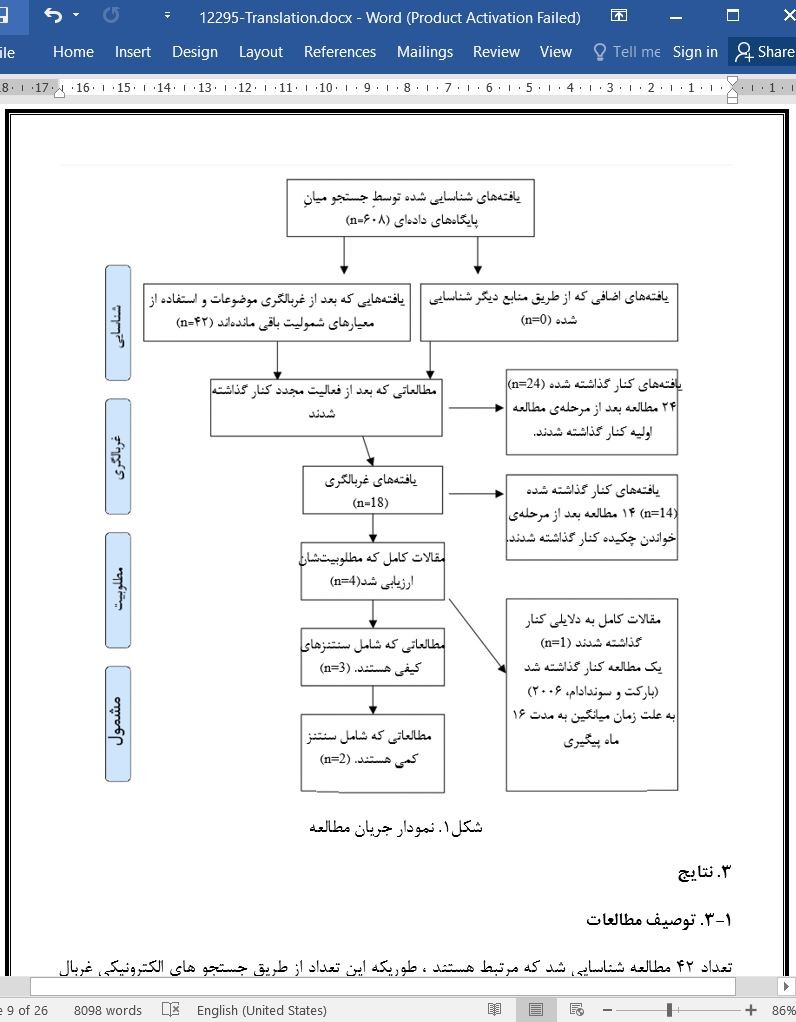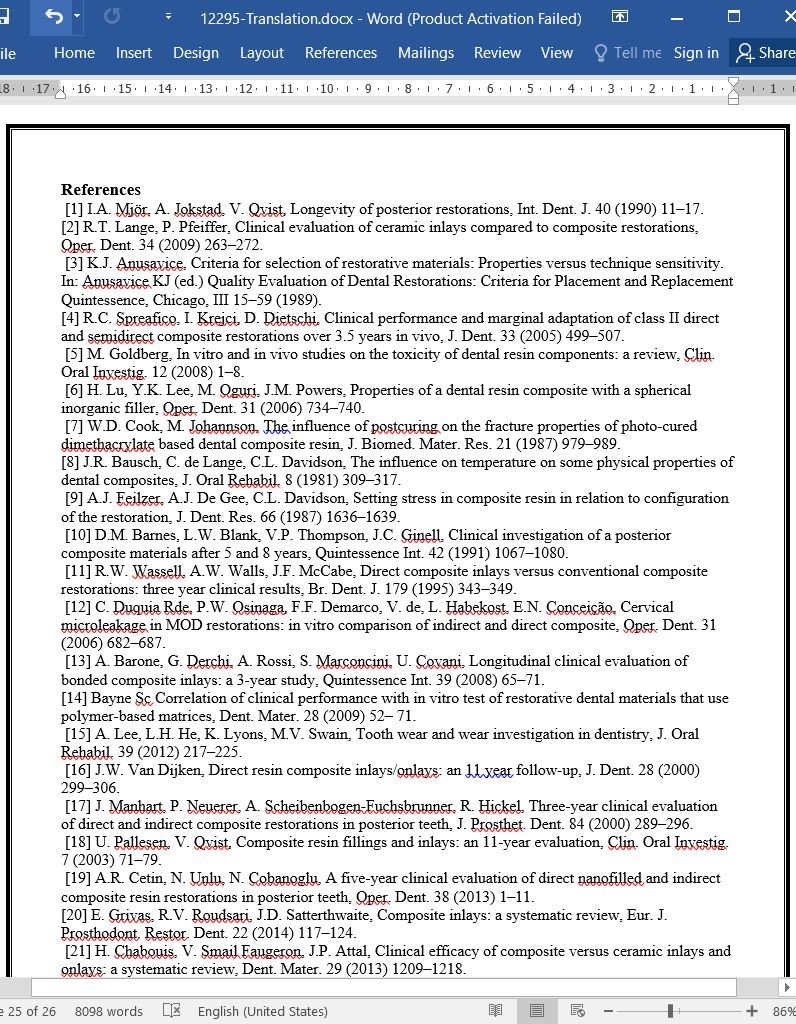
روش های ترمیمی مستقیم در برابر روشهای غیر مستقیم کامپوزیت اینلی و آنلی در دندان های عقبی دهان
چکیده
هدف: ارزیابی طولانی مدت عملکرد بالینی روش های مستقیم در مقابل روش غیر مستقیم کامپوزیت اینلی/آنلی در دندان های عقبی
داده ها: ارزیابی مطلوب بودن شمولیت و ارزش یابی کیفیت مطالعات و استخراج داده ها به طور مستقل توسط دو نویسنده انجام گرفته است.
منابع: پایگاه داده ای الکترونیک مدلاین، ایمبیس ، آزمایشات گروه سلامت دهان کوکران و سنترال مورد جستجو قرار گرفتند (14/12/2015)، بدون هیچ محدودیتی در تاریخ و زبان. ما تنها آزمایشات کنترل شده ی تصادفی را منظور کردیم و آن ها را طبق ریسک خطای کوکران ارزیابی کردیم.نتایج اصلی که مورد ارزیابی قرار گرفتند عدم موفقیت درمان بود که توسط چندین پارامتر ارزیابی شدند.
انتخاب مطالعه: دو مطالعه که موارد مستقیم و غیر مستقیم اینلی را ارزیابی کردند (82بیمار با248 درمان) و یک مطالعه برای آنلی(157 بیمار با 176 درمان) کرایتریای درمانی را شمال شدند. دو آزمایش یکی ناواضح و یکی هم ریسک بالای خطا را داشتند، که به لحاظ ریاضی قابل ترکیب بودند. متاآنالیز هیچ تفاوت قابل توجه آماری را نشان نمی داد که شکست بین روش مستقیم و غیر مستقیم اینلی را شامل شود آن هم بعد از 5 سال. (RR=1.54 ؛ 95% Cl:0.42، 5.58؛P=0.52) یا بعد از یازده سال از عملکرد(RR=0.95 ؛ 95% Cl:0.34، 2.63؛P=0.92). تنها یک پارامتر،رنگ رفتگی حاشیه ها، به شکل خفیفی نتایج را به سمت اینلی مستقیم متمایل می کند که بعد از یازده سال اتفاق می افتد. (RR=0.41 ؛ 95% Cl:0.17، 0.96؛P=0.04). تنها یک مطالعه بر اساس آنلی است، که دوام 5 ساله را 87% (95%Cl : 81-93%) بیان می کند.
نتیجه: تفاوت دوتکنیک مفهومی آماری را به منظور توصیه ی یک تکنیک خاص نسبت به سایرین بیان نمی کند.کمبود مطالعات اولیه،نیاز برای مطالعات بیشتر سازمان یافته ی طولانی مدت جهت دستیابی به نتایج قطعی درمورد این دو تکنیک را تاکید میکند.
اهمیت بالینی: کواد کامپوزیت رزینی ،که مستقیم یا غیر مستقیم قرار می گیرند،ترمیم بالینی طولانی مدتی را لحاظ می کنند که درمان مجدد دندان های عقبی در این زمان مورد نیازند.اگر چه سال های زیادی در حرفه بالینی ، انتخاب بهترین پروتکل درمانی هنوز مورد سوال است. مطالعات در دسترس،شواهد معتبری در این زمینه فراهم نکرده اند.
1.مقدمه
عدم موفقیت درترمیم های دندانی شکایت مهمی را در زمینه حرفه دندانپزشکی روزمره ایجاد کرده است.گزارش شده است که 60 درصد حجم کار دندانپزشکی مربوط به ترمیم اولیه و یا ترمیم مجدد دندان هاست ]1[ . به کاربردن مواد مناسب و تکنیک درست به عنوان فاکتورهایی کلیدی هستند که برروی موفقیت و یا عدم موفقیت ترمیم درمان اثر می گذارند ]2[.
5. نتیجه گیری
به طور کلی، شواهد کافی برای ارائه توصیه های دقیق به نفع روش های مستقیم بیش از روش غیر مستقیم است. نتایج بررسی و متاآنالیز ما از مطالعاتی با ریسک بالای خطا و نامشخص ناشی می شود. مطمئنا، مطالعات طولانی مدت که به خوبی طراحی شده اند باید انجام شود تا تفاوت های معنا داری و یا توصیه هایی مربوط به هر دو تکنیک مقایسه شود.
Abstract
Objective To evaluate the long-term clinical performance of direct versus indirect composite inlays/onlays in posterior teeth.
Data Screening for inclusion eligibility, quality assessment of studies and data extraction was performed independently by two authors.
Sources The electronic databases MEDLINE, EMBASE, Cochrane Oral Health Group’s Trials Register and CENTRAL were searched (14.12.2015), with no restriction to publication date or language. We included only randomised controlled trials (RCTs) and evaluated them according to Cochrane risk of bias tool. The main outcome assessed was the restoration failure, determined by several clinical parameters.
Study selection Two studies concerning direct and indirect inlays (82 patients with 248 restorations) and one study for onlays (157 patients with 176 restorations) satisfied the inclusion criteria. Two trials, one of unclear and one of high risk of bias, could be mathematically combined. The meta-analysis indicated no statistically significant difference in the risk failure between direct and indirect inlays, after 5 years (RR: 1.54; 95% Cl: 0.42, 5.58; p = 0.52) or 11 years of function (RR: 0.95; 95% Cl: 0.34, 2.63; p = 0.92). Only one parameter, the marginal discoloration, slightly favored direct inlays after 11 years (RR: 0.41; 95% Cl: 0.17, 0.96; p = 0.04). Only one study dealt with onlays; an overall 5-year survival of 87% (95% CI: 81–93%) was reported.
Conclusion The difference of the two techniques did not reach statistical significance in order to recommend one technique over the other. The scarcity of primary studies support the need for further well-designed long-term studies in order to reach firm conclusions about both techniques.
Clinical significance Resin composite materials, placed directly or indirectly, exhibit a promising long-term clinical performance when rehabilitation of posterior teeth is needed. Although many years in clinical practice, the selection of the best treatment protocol still remains subjective. The available studies, and their synthesis, cannot provide reliable evidence in this field.
1. Introduction
Failure of dental restorations presents a major complication in everyday dental practice. It has been reported that about 60% of all operative dental workload refers to placement and replacement of restorations [1]. Correct material manipulation and proper technique selection may be regarded as the key factors that affect restoration success or failure [2].
5. Conclusions
Overall, there is insufficient evidence to make strict recommendations in favor of direct over indirect technique. The results of our review and meta-analysis derive from studies with unclear and high risk of bias. Certainly, further well-designed long-term studies should be undertaken in order to make more meaningful comparisons or recommendations about both techniques.
چکیده
1.مقدمه
2. مواد و متد ها
2-1. پروتکل و نحوه ثبت
2-2. کرایتریای انتخاب مورد استفاده برای مطالعات
2-3. استراتژی جستجو برای شناسایی مطالعات
2-4. انتخاب مطالعات
2-5. استخراج داده ها و مدیریت
2-6. ارزیابی های اثرات درمان
2-7. بخش مسائل تجزیه و تحلیل
2-8. برخورد با اطلاعات از دست رفته
2-9. ازریابی ناهمگونی
2-10. ارزیابی کیفیت
2-11. ارزیابی گزارش تعصب ها در مطالعات
2-12. ارزیابی گزارش خطا
3. نتایج
3-1. توصیف مطالعات
3-2. ارزیابی کیفیت
3-3. تشکیل کمی مطالعات
3-3-1. اثرات مداخلات
3-3-2. پوسیدگی های ثانویه
3-3-3. حساسیت پس از جراحی
3-3-4. کیفیت زیبایی
4. بحث
4-1. کیفیت شواهد
4-2. پیامدهای تحقیق
5. نتیجه گیری
منابع
ABSTRACT
1. Introduction
2. Materials and methods
2.1. Protocol and registration
2.2. Selection criteria applied for the review
2.3. Search strategy for identification of studies
2.4. Selection of studies
2.5. Data extraction and management
2.6. Measures of treatment effect
2.7. Unit of analysis issues
2.8. Dealing with missing data
2.9. Assessment of heterogeneity
2.10. Quality assessment
2.11. Assessment of reporting bias
2.12. Data synthesis
3. Results
3.1. Description of studies
3.2. Quality assessment
3.3. Quantitative synthesis of included studies
3.3.1. Effects of interventions
3.3.2. Secondary caries
3.3.3. Postoperative sensitivity
3.3.4. Esthetic quality
4. Discussion
4.1. Quality of the evidence
4.2. Implications for research
5. Conclusions
References
- اصل مقاله انگلیسی با فرمت ورد (word) با قابلیت ویرایش
- ترجمه فارسی مقاله با فرمت ورد (word) با قابلیت ویرایش، بدون آرم سایت ای ترجمه
- ترجمه فارسی مقاله با فرمت pdf، بدون آرم سایت ای ترجمه



